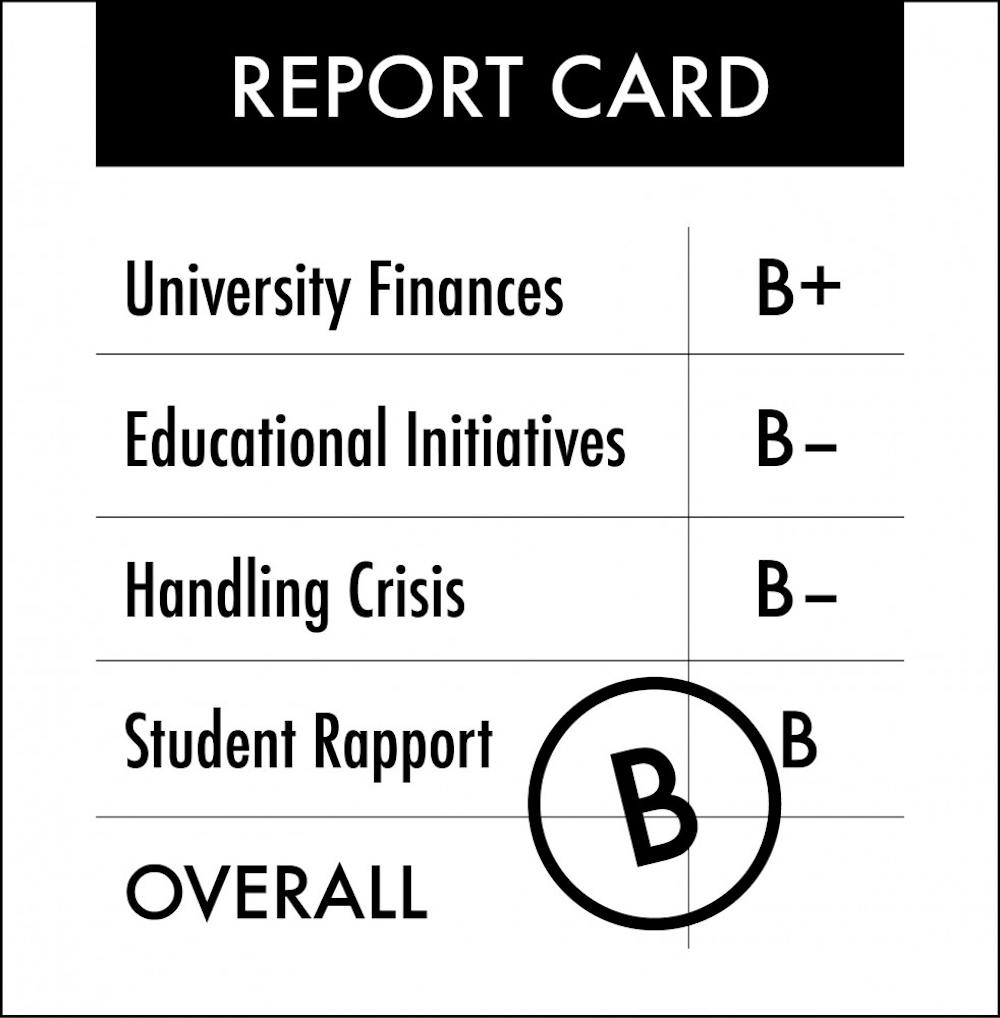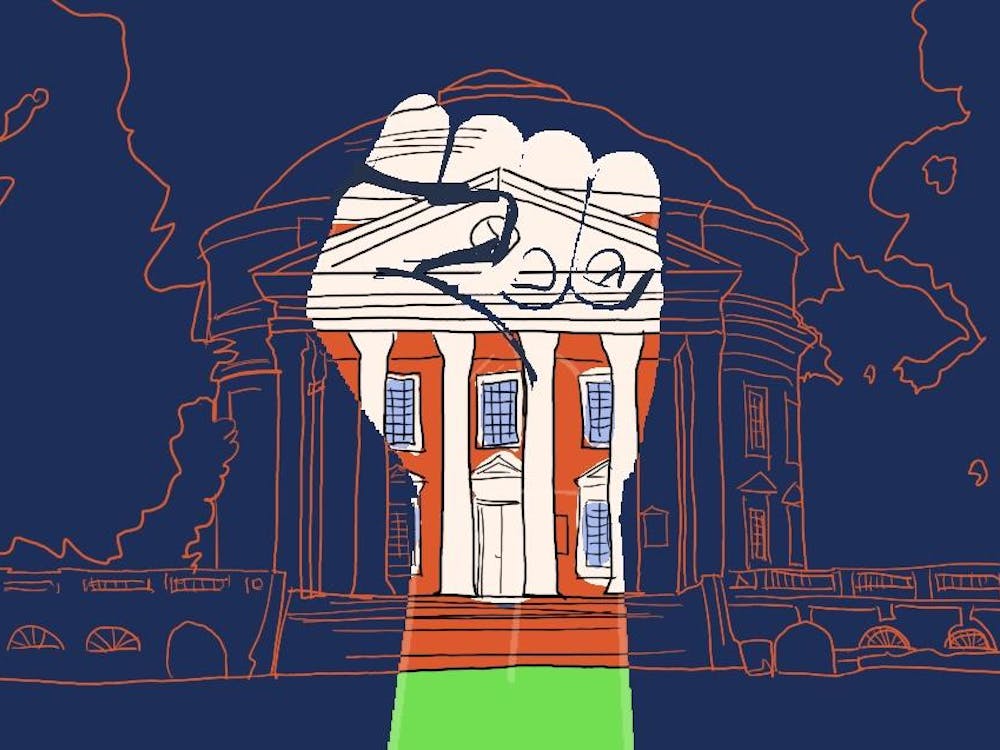Recently, Virginia legislators have debated the quality of University President Teresa Sullivan’s leadership, with Del. David Ramadan, R-Loudon, calling for Sullivan’s resignation. In response, Del. David Toscano, D-Charlottesville, and Del. Jimmie Massie, R-Richmond, have voiced their support for Sullivan.
Ramadan’s critique of Sullivan stems mostly from her handling of sexual assault at the University, while Toscano and Massie counter that Sullivan has worked with the General Assembly to produce three new laws addressing sexual assault. Toscano and Massie stress that it is not the role of members of the General Assembly “to micromanage the affairs of our colleges and universities.”
In this debate, it is important to understand what, exactly, the role of a university president is. While being personable and handling crises are crucial elements of a president’s job, for the most part the role of a president is largely administrative. The president represents her institution to the external community, but she also handles infrastructural changes, strategic planning and financial decisions. Given this understanding and the futility of a General Assembly debate over Sullivan, we offer our own assessment of the work she has done.
University finances: B+
From a macro perspective, the financial landscape has changed significantly for our University between the tenure of Sullivan’s predecessor, John Casteen, and her time in office. When Casteen took office in 1990, according to the New York Times the state government provided a quarter of the University’s budget; by the time Sullivan took office in 2010 it provided less than 7 percent. The moment she came to Grounds, Sullivan made increasing revenue a priority, choosing not to expand the student body or increase tuition but instead hiring a consultant to study the University Hospital’s finances — a part of the University that constitutes nearly half the budget. Early in her tenure, following in her predecessor’s footsteps, Sullivan also made fundraising a priority. While not nearly as charismatic as her predecessor, Sullivan has done a decent job of bringing in donations, obtaining a $15 million donation from Paul Tudor Jones for a Contemplative Sciences Center. According to Fortune Magazine, cash flow for this fiscal year is also up 29 percent — but last fiscal year U.Va. reported only $224 million in cash flow, and the peak cash flow under Casteen’s leadership was $302 million in 2007. Sullivan’s record doesn’t compete with Casteen’s, but it is still relatively good.
Generally speaking, under Sullivan’s leadership the University has seen financial improvements. While new gift and pledge amounts to the University decreased 3.6 percent between Fiscal Year 2014 and Fiscal Year 2015, total new commitments combined with new future support totaled a 19 percent increase over Fiscal Year 2014. As of 2014, the University ranked near the top of foundation giving nationwide, and just last month, the University of Virginia Investment Management Company reported a 7.7 percent return on investments in the last 12 months. This will put the University in the upper quartile when compared with its peers, according to the UVIMCO chief executive officer.
These successes are not solely Sullivan’s, and this is also not to suggest the University has not had to make tough financial decisions. Last spring, the Board of Visitors voted to increase tuition drastically in order to subsidize low-income students, something its budget could not do without tuition increases across the board. But subsidizing low-income students’ education has also been a priority for Sullivan when allocating finances, inside and outside the University. According to Sullivan, she started lobbying for changes to the deadline for the Free Application for Federal Student Aid as early as two years ago, and last month the Obama administration announced its plan to do just that. Not only has the University’s revenue increased, but Sullivan appears to have the right priorities when it comes to allocation of that revenue.
Educational initiatives: B-
Sullivan’s five-year Cornerstone Plan is her most all-encompassing educational project. Elements of the project offer widespread improvements, such as programs aimed at creating “Total Advising” by increasing the number of COLA courses and creating pilot seminars in the Engineering School, as well as the potential creation of an advising center in Clemons Library. Advising at our University has long been in need of improvement, and is a necessary focus for the administration. In addition to academic advising, the Cornerstone Plan emphasizes career advising.
Sullivan’s goal, according to UVA Today, is to ensure that by 2018 every University student will be able to attend a small seminar during their first year and have the option to study or work abroad or conduct globally oriented research (the latter via the University’s new global internship program). These are commendable goals.
One area of continued concern is recruitment and retention of faculty. The biggest faculty-based initiative is the Faculty Forward plan for the College, a project aimed at adding $100 million to the endowment for faculty support and raising $30 million in spendable gifts. Ultimately, the initiative should result in the hiring of 250 to 300 new College faculty — something our expanding school certainly needs. Recruiting minority faculty members is also a key consideration. In a letter in response to the Black Student Alliance’s proposal “Towards a Better University,” Sullivan noted numerous efforts to recruit minority faculty members, including subcommittees formed in University schools to research and make recommendations on the issue, hiring committees that collaborate with UVa CHARGE — a program designed to increase faculty diversity in the sciences — and resource groups created to support hired minority faculty. At this point, it is too soon to tell whether these initiatives will be effective.
These goals are promising, but we have yet to see many deliverables.
Handling crisis: B-
In Sullivan’s tenure, there have been five notable crises: the murder of student athlete Yeardley Love by George Huguely, a member of the University lacrosse team; the ousting of Sullivan herself by the Board of Visitors in 2012; the disappearance and death of second-year student Hannah Graham; the release of Rolling Stone’s now-retracted article on sexual assault; and the brutal arrest of then third-year student Martese Johnson last spring. These challenges came alongside other tragedies, including student suicides and deaths, as well as smaller public relations fiascos, such as the accidental release of roughly 18,700 students’ social security numbers in 2013 and the hacking of the University’s information technology by attackers in China.
The high volume of crises that have occurred at U.Va. under Sullivan’s tenure led Fortune Magazine to call her “the unluckiest president in America.” And while that description may fit, her leadership at these times has wavered tremendously.
Sullivan handled her ouster with remarkable calm, largely leaving it to the public to advocate for her reinstatement. She refused to badmouth the Board of Visitors in the aftermath of their coup. That the Board ousted her suggests an inability on her part to mitigate concerns between herself and members of the Board — certainly an element of a president’s job — but she transitioned back into her role smoothly.
She handled Love’s death and Graham’s disappearance with relative sensitivity. Entering office three months after Love was killed, Sullivan staged a “Day of Dialogue” that attracted over 1,500 students who discussed domestic violence and bystander intervention. Sullivan also implemented voluntary sessions on bystander intervention training. The death of Hannah Graham occurred off-Grounds and Sullivan was as visible as necessary in responding to that tragedy. The latter two crises, however, require more discussion.
On the day Rolling Stone published “A Rape on Campus,” Sullivan left the country to attend a conference. She wrote students a defensive email in response to the article and left many searching for a sign of empathy in her leadership. As emotions on Grounds rose high, Sullivan’s response did little to mediate student concerns.
While Sullivan’s emotional handling of the event left many students frustrated, addressing sexual assault has been a priority for her administration, before and after Rolling Stone’s article. Regardless of the messiness of suspending Greek life and then reinstating it, Sullivan has taken concrete steps to improve University policy, including the revision of the University’s sexual misconduct policy, the hiring of new personnel and the implementation of a mandatory sexual assault prevention module. None of these initiatives will solve the problem of campus sexual assault — but they are all positive steps in that direction.
In response to Johnson’s arrest, Sullivan called upon the governor’s office to investigate the incident. As the event occurred off-Grounds, there was not much more administratively Sullivan could do than provide personal support for Johnson and affected students. But the personal support she provided — which came in the form of yet another statement — felt insufficient to many students.
In her handling of these crises, Sullivan fell short most in her ability to connect at an emotional level at a time when students desperately needed it. As Student Council President Abraham Axler said to Fortune, Sullivan has “struggled to provide the emotional leadership that the community needs.” To be fair, as Sullivan said to Fortune, “If I were highly emotional, I would be criticized for that.”
Student rapport: B
Sullivan is not known for being a particularly engaging speaker or jovial figure. She certainly engages with students, even teaching her own COLA course and advising the first-year students in that seminar, but she has never been seen as a particularly visionary president.
Preferring a quiet style of leadership, Sullivan did not rise to the role of being a populist president following her reinstatement. Quiet leadership is still leadership — but quiet leadership can also easily be seen as aloofness, especially during times of crisis. In one-on-one conversations Sullivan can be quite personable, but few University students get the chance to see that side of her. Notably, she consistently communicates well with student media groups.
Looking to the future
Last semester, Sullivan’s contract was extended until July 2018. This will provide her with enough time to finish carrying out the Cornerstone Plan and other initiatives mentioned above. When considering Sullivan’s leadership, it is important to take into account the entire context of her presidency, which has only lasted five years so far. Sullivan’s leadership has seen highs and lows — and, largely due to chance, more lows than highs. In an unusual set of circumstances, Sullivan has been able to keep her goals on track.







